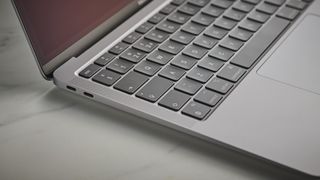iPhone 15 USB-C - here's everything you need to know
Apple's latest iPhones have finally ditched Lightning ports for USB-C

Apple has finally ditched the Lighting port in favour of USB-C for the entire iPhone 15 family, including the iPhone 15 Plus, iPhone 15 Pro and iPhone 15 Pro Max.
Revealed at the Apple September event, these four phones will now charge and offer data transfer over the most common physical smartphone connection.
Apple may have been slow to make the move, but it's a significant one. So in this article we'll explain what USB-C is, why matters for iPhones, and what differences there are between the standard and Pro models.
What is USB-C?
USB-C is the latest universal standard for the wired connection of smart devices. If you buy a smart device in 2023 – be it one of the best Android phones, best laptops or best smart speakers – it’ll likely feature a pill-shaped port to support USB-C charging and data transfer.
A USB-C connector has 24 pins in total, 16 of which are for data transfer, four are for charging and four are ground pins. USB-C cables are reversible, meaning you can insert them into their corresponding ports face-up or face-down, it doesn't matter.

It’s worth noting that USB-C isn’t a data standard, so you can’t tell how fast a given USB-C cable is without looking at its corresponding number (which indicates speed). There are a number of different types of USB-C cables, including USB 2.0, 3.0 and Thunderbolt 4.
In October 2022, the European Union (EU) finalized a regulation requiring companies to include universal USB-C charging ports on all new technology products sold in EU countries from the end of 2024.
iPhone gets USB-C
Apple was steadfast in not adopting USB-C when it became the de facto standard for many Android phones, meaning the some of the best iPhones still have Lightning ports. However, the European Union's dictat to have smartphones use a common connection standard by 2024, likely forced Apple to move to USB-C; not that it mentioned this in official media materials. So from September 2023 onwards, we can expect all new iPhones to have a USB-C ports.

What does USB-C mean for iPhone 15?
In short, it means a common connection that will result in you not having to use a proprietary cable and charger for iPhone 15 models and beyond. It also facilitates faster data transfer speeds.
And there's scope for faster charging, though Apple hasn't detailed this. You will be able to use the USB-C port to also charge peripherals, such as Apple's AirPods.
What are the differences between iPhone 15 and iPhone 15 Pro USB-C?
In typical Apple fashion there's a difference in the USB standards Apple gives the USB-C controller in the iPhone 15 and iPhone 15 Pro models. The iPhone 15 and 15 Plus comes with a USB 2 standard connection, which is somewhat archaic for 2023, only offering data transfer speeds of up to 480 megabits per second.
Conversely, the iPhone 15 Pro and iPhone 15 Pro Max USB-C port has a USB 3 standard controller allowing for data transfer speeds of up to 10 gigabits per second. So if you shoot a lot of large videos or a lot of photos on your iPhone that you want to quickly transfer to a Mac or external storage, you'll want to go for a Pro iPhone 15 model.
While it's great that Apple has finally adopted a USB-C connector for its latest iPhones, the gap between the standard and Pro models is frustrating.
At the time of writing, a USB-C port with a USB 2 standard is pretty old in tech terms, So it's a tad baffling why Apple would give the iPhone 15 and iPhone 15 Plus such a slow USB controller.
Get daily insight, inspiration and deals in your inbox
Get the hottest deals available in your inbox plus news, reviews, opinion, analysis and more from the TechRadar team.
A USB 3 standard USB-C connection on the iPhone 15 Pro and iPhone 15 Pro Max makes a lot more sense, given these phones can capture detailed photos and videos, both of which can result in chunky files that require a fast connection to transfer them from the phone's storage to a computer or external hard drive.
It's a pity Apple hasn't gone for one USB-C standard across the iPhone 15 range. But then again Apple is no stranger in separating specs and features between its standard iphones and the Pro models.
Roland Moore-Colyer is Managing Editor at TechRadar with a focus on phones and tablets, but a general interest in all things tech, especially those with a good story behind them. He can also be found writing about games, computers, and cars when the occasion arrives, and supports with the day-to-day running of TechRadar. When not at his desk Roland can be found wandering around London, often with a look of curiosity on his face and a nose for food markets.
- Axel MetzSenior Staff Writer
Most Popular

